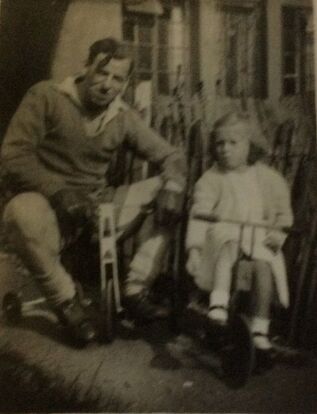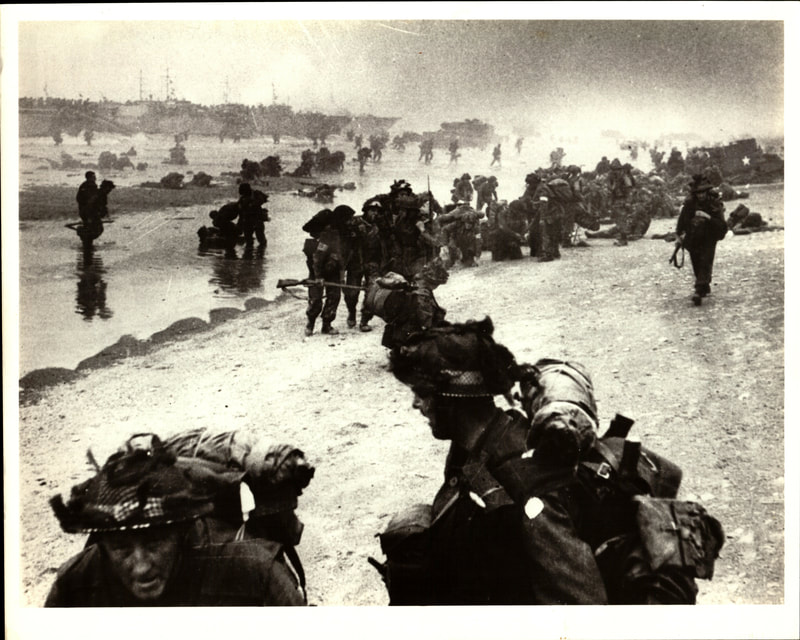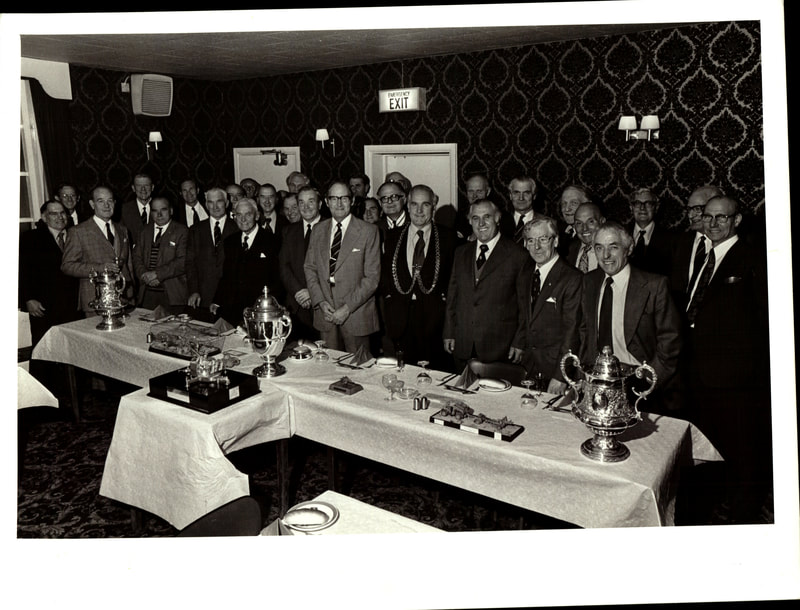Stan Baines
Stan Baines is another Norfolk man who was fighting in the area close to Le Paradis in an attempt to halt the German advance before being evacuated off the beaches of Dunkirk.
Stan kept accounts of his time with the 53rd Field regiment of the Royal Artillery and these are reproduced on this page with the permission of his daughter Linda and his family.
Stan was a chef by trade in Manchester and was born on June 17th, 1919. He became a regular soldier on September 1st, 1939, when he joined up at his local drill hall. After being billeted to an old mill in Bury, Lancashire, Stan joined the 53rd Field Regiment of the Royal Artillery as a signalman.
Stan and his regiment subsequently moved to Northumberland to continue their training before sailing to Cherbourg in France and onwards to their destination which was Lambersart near Lille.
"For a while we enjoyed a quiet time visiting the local establishments for a drink with frequent visits to the nightlife in Lille dancing in the square. This brief spell of heaven was soon to end as Hitler had decided to launch is Blitzkeieg," Stan wrote in his memoir.
The regiment travelled to an unknown destination ready to "face the might of the German onslaught." The reality of war soon set in:
"Our convoy was soon attacked by German fighter bombers. The road was soon a shambles and filled by civilians trying to escape the bombs, machine guns and shellfire. Our progress was very slow; civilians were cluttering the roads with families with young children carrying their belongings in all sorts of conveyances - prams, handcarts, wheelbarrows......every now and then we were forced to take shelter in the ditches at the side of the road already occupied by civilian men, women and children.
"With death and destruction all around we slowly progressed to the position we were trying to hold with artillery fire. Our guns were peashooters compared to the German guns. At last we pulled into a farm, our designated position, and made our Headquarters."
Stan's stay in France was a short albeit brutal one as he marched with comrades back towards Dunkirk: "We eventually found our way to the Bray Dunes within a few miles of Dunkirk. All this time we were being dive bombed and strafed by Stukas," he wrote.
Eventually Stan made it into a rowing boat and rowed, along with numerous others, to one of the naval ships waiting to pick them up.
Stan reached Harwich safely to be given a hero's welcome: "We were cheered by the people who had lined the road and treated like heroes. I certainly didn't feel very heroic - cold, wet and very bedraggled," he said.
Below is the extended version of Stan's experiences which he typed himself.
Stan kept accounts of his time with the 53rd Field regiment of the Royal Artillery and these are reproduced on this page with the permission of his daughter Linda and his family.
Stan was a chef by trade in Manchester and was born on June 17th, 1919. He became a regular soldier on September 1st, 1939, when he joined up at his local drill hall. After being billeted to an old mill in Bury, Lancashire, Stan joined the 53rd Field Regiment of the Royal Artillery as a signalman.
Stan and his regiment subsequently moved to Northumberland to continue their training before sailing to Cherbourg in France and onwards to their destination which was Lambersart near Lille.
"For a while we enjoyed a quiet time visiting the local establishments for a drink with frequent visits to the nightlife in Lille dancing in the square. This brief spell of heaven was soon to end as Hitler had decided to launch is Blitzkeieg," Stan wrote in his memoir.
The regiment travelled to an unknown destination ready to "face the might of the German onslaught." The reality of war soon set in:
"Our convoy was soon attacked by German fighter bombers. The road was soon a shambles and filled by civilians trying to escape the bombs, machine guns and shellfire. Our progress was very slow; civilians were cluttering the roads with families with young children carrying their belongings in all sorts of conveyances - prams, handcarts, wheelbarrows......every now and then we were forced to take shelter in the ditches at the side of the road already occupied by civilian men, women and children.
"With death and destruction all around we slowly progressed to the position we were trying to hold with artillery fire. Our guns were peashooters compared to the German guns. At last we pulled into a farm, our designated position, and made our Headquarters."
Stan's stay in France was a short albeit brutal one as he marched with comrades back towards Dunkirk: "We eventually found our way to the Bray Dunes within a few miles of Dunkirk. All this time we were being dive bombed and strafed by Stukas," he wrote.
Eventually Stan made it into a rowing boat and rowed, along with numerous others, to one of the naval ships waiting to pick them up.
Stan reached Harwich safely to be given a hero's welcome: "We were cheered by the people who had lined the road and treated like heroes. I certainly didn't feel very heroic - cold, wet and very bedraggled," he said.
Below is the extended version of Stan's experiences which he typed himself.
Stan went on to fight in the Middle East and then took part in the Normandy landings and the final push into Germany.
In June 1942 Stan married Norfolk lass Joan and set-up his home in Norwich. He lived in the county for the rest of his life, becoming a leading light in the Royal British Legion. After the war he heard about the massacre at Le Paradis and became a standard bearer for the Norfolk branch of the Dunkirk Veterans' Association for visits and pilgrimages for almost 40 years until it folded in 2000. Very much an extrovert, Stan loved singing and dancing and raising money for charity from such pursuits as abseiling.
After leaving the Forces, Stan spent most of his working life in the catering section of the National Health Service. After retiring, he became an entertainer and helped to run youth centres.
"Every day I think about just how lucky I am. After all these years, I am having such a happy life. So many of my comrades never had that chance," he told the Eastern Daily Press newspaper in 2003.
Below are two Christmas cards sent by Stan to his wife Joan along with a letter. We are very grateful to Stan and Joan's daughter Linda Stimpson for permission to print them. Linda points out that Christmas cards were severely censored and not even kisses (xxxxx) were allowed. You can see Stan's comments on this in the bottom picture. Click on the photographs to enlarge them. Below that is a gallery of photographs from Stan's life including visits to Le Paradis - one of which also features Bill O'Callaghan.
In June 1942 Stan married Norfolk lass Joan and set-up his home in Norwich. He lived in the county for the rest of his life, becoming a leading light in the Royal British Legion. After the war he heard about the massacre at Le Paradis and became a standard bearer for the Norfolk branch of the Dunkirk Veterans' Association for visits and pilgrimages for almost 40 years until it folded in 2000. Very much an extrovert, Stan loved singing and dancing and raising money for charity from such pursuits as abseiling.
After leaving the Forces, Stan spent most of his working life in the catering section of the National Health Service. After retiring, he became an entertainer and helped to run youth centres.
"Every day I think about just how lucky I am. After all these years, I am having such a happy life. So many of my comrades never had that chance," he told the Eastern Daily Press newspaper in 2003.
Below are two Christmas cards sent by Stan to his wife Joan along with a letter. We are very grateful to Stan and Joan's daughter Linda Stimpson for permission to print them. Linda points out that Christmas cards were severely censored and not even kisses (xxxxx) were allowed. You can see Stan's comments on this in the bottom picture. Click on the photographs to enlarge them. Below that is a gallery of photographs from Stan's life including visits to Le Paradis - one of which also features Bill O'Callaghan.
The letter above includes the words "Sorry Darling but I am not allowed to put kisses ???? doesn't like it. Cheerio Sweetheart

Stan was well known in Le Paradis and the surrounding area and when he died his family received a letter of condolence from the Creton family.
Stan also kept a diary of the workings of the Norfolk branch of the Dunkirk Veterans' Association and these are reproduced below. Click on the images to enlarge,
Stan also kept a diary of the workings of the Norfolk branch of the Dunkirk Veterans' Association and these are reproduced below. Click on the images to enlarge,
More of Stan's Photos
|
Top left - Out for a Sunday Tandem ride, Joan, Stan and Linda outside either Surlingham or Reedham Ferry Inn. Linda says "we were all teetotal but it was a good place to stop." Next to that is a picture taken in Norwich prior to the Forum being built. Stan with comrades. Stan is front far right. Below that is Stan on the far left in Latakia, Syria, May 1943. Notice the camel. Opposite is Stan with Cissie Collen enjoying a dance at the 2000 trip to Dunkirk. The picture was taken in Du Panne. |
Stan pictured during his time as manager of the staff canteen at Curls Department store in Norwich.
|
In the top photograph was taken at Latakia in Syria in 1943. Left to right are - Eric Moon, Alex Martin, Sid Davies and Stan Baines.
Below that is Stan with another group and on the right Stan is on his Claude Butler bike when he lived at Rackheath. Note the latrines and Nissan hut in the background. |
|
The top three pictures in this sequence are of Stan in his chef's outfit. The first is at Aylsham Road Drill Hall in Norwich. The other top photos have Bude in Cornwall written on the back and were probably taken when Stan was in the Territorial Army. Opposite is Stan and helper at Kalkar in Germany after the war. On the right is a group at Bude.
|
Some Pages From Stan's Soldier's Record and Pay Book
And Finally ............ Press Cuttings and menus











































































